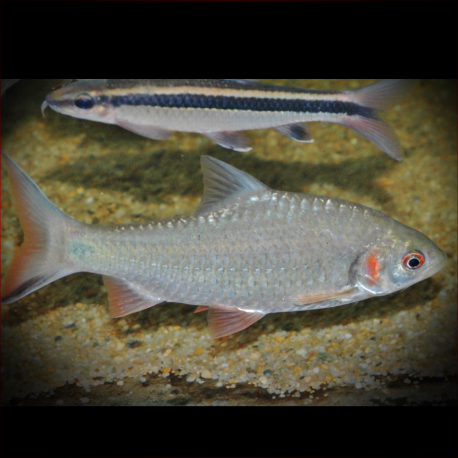More info
Datasheet
| Minimum Tank Size | 720 litres / 190.20 US gallons |
| Maximum Size | 25.0cm / 9.84inches |
| Temperature | 18°C / 64.40°F - 26°C / 78.80°F |
| Hardness | 2.02dgH / 36ppm - 20.00dgH / 357ppm |
| pH | 6.0-8.0 |
Behaviour
This species is known to be quite boisterous and can easily intimidate smaller and less robust species due to its size and activity, particularly during feeding times. In a spacious aquarium, it can coexist with other robust fish species like similarly-sized cyprinids that dwell in open water, as well as benthic species such as Garra and botiid loaches. It is advised to conduct thorough research before introducing this fish to avoid any potential conflicts. In the wild, Systomus Orphoides forms aggregations; hence, it is recommended to purchase at least six or more specimens to reduce skittish behavior and create a more natural display. Aggressive behavior within the group is usually contained as the fish focus on maintaining their hierarchical position.
Aquarium Setup
The recommended tank setup for Systomus Orphoides involves creating an environment that mimics a flowing stream or river, with a substrate consisting of variably-sized water-worn rocks, sand, fine gravel, and possibly small boulders. Additional decorations such as driftwood roots or branches can be included, and hardy plants like Microsorum, Bolbitis, or Anubias spp. can be grown attached to the decor. Due to its natural habitat in pristine waters, this species is sensitive to the accumulation of organic pollutants, requiring clean water conditions with a high level of dissolved oxygen and moderate water movement. Detailed water condition parameters include a pH range of 6.0-8.0, water hardness between 36-357ppm, and a temperature range of 18-26°C.
Feeding and Diet
In the wild, Systomus Orphoides is believed to be a forager, consuming diatoms, algae, organic detritus, small insects, worms, crustaceans, and other zooplankton. In aquariums, it is an easily-fed species that thrives on a diet of small live and frozen foods like bloodworms, Daphnia, and Artemia, supplemented with high-quality dried flakes and granules. It is recommended to provide some food options that contain additional plant or algal content to support optimal health and vibrant colors.
Reproduction & Dimorphism
While reproduction of Systomus Orphoides in captivity is scarcely documented, it is known to be cultured as a food fish in its native range. As an egg-scattering species without parental care, a single female can release thousands of eggs during spawning. Successful breeding in an aquarium setting would require preventing the adults from consuming the eggs, a dedicated breeding tank, and the necessary resources to raise and distribute the numerous juvenile fish. Adult males display a more intense coloration and develop noticeable tubercules on the head during spawning phases, while adult females tend to grow larger, have a heavier build, and show less vibrant colors.
Habitat and Distribution
Systomus Orphoides primarily inhabits flowing tributaries, large streams, and surrounding floodplains. During the wet season, these fish move into inundated agricultural areas and forests for feeding and spawning, returning to the main rivers as the water levels recede. They are also found in larger rivers and permanent water bodies, including seasonal systems like the Tonlé Sap in Cambodia. Its distribution ranges from India and Myanmar through Southeast Asia to the Greater Sunda Islands, showcasing a wide variation in appearance across different localities due to recognized variants with distinct red color patterns in the finnage.

